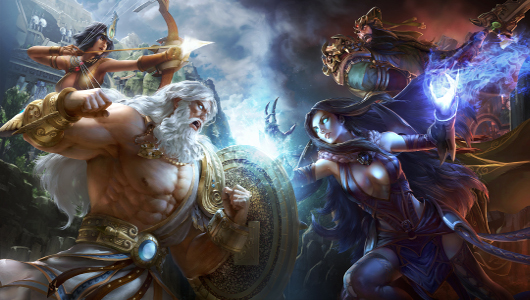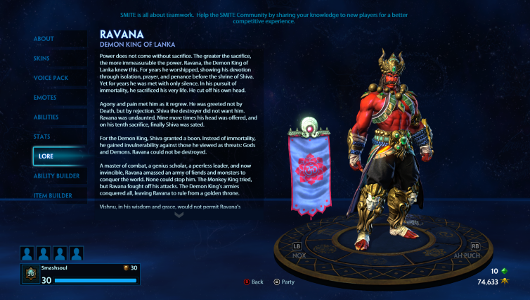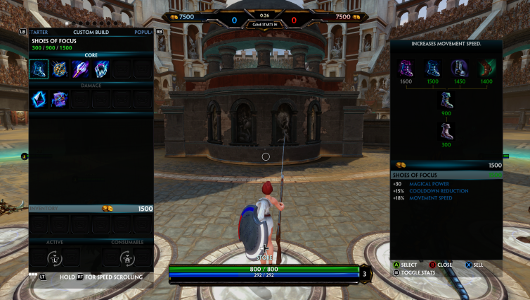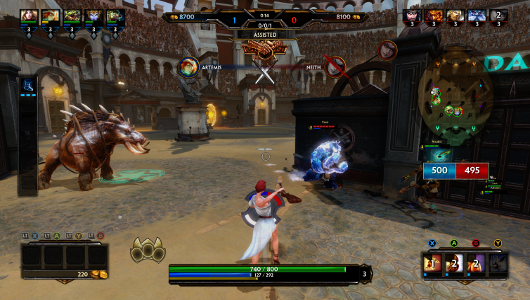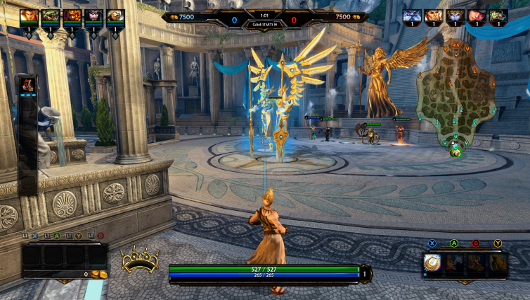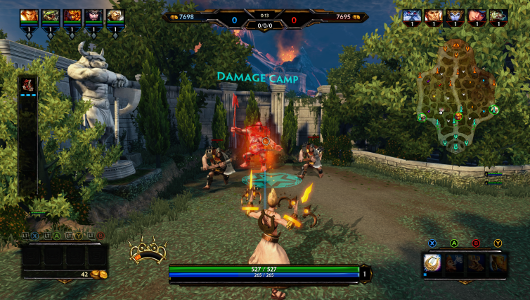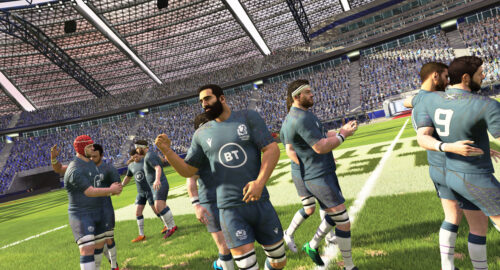The MOBA genre is one that hasn’t really been prominent on consoles. In fact, aside from Guardians of Middle-earth which released a few years ago, there hasn’t really been anything which could classify itself as a full blown MOBA.
This is where SMITE comes in. A very successful free-to-play MOBA on PC, SMITE has been in alpha and beta on the Xbox One since March and has slowly been moving its way towards official release. But the main question that needs asking is this; can a MOBA that originated on PC truly transition to – and make itself at home – on the Xbox One? In short, yes, it absolutely can.
• Developer: Hi-Rez Studios
• Publisher: Hi-Rez Studios
• Reviewed on: Xbox One
• Also Available On: PC
• Release Date: Available Now
In SMITE, you choose from a massive selection of 60+ gods and immortals to play as from across the Chinese, Egyptian, Norse, Greek, Mayan and Hindu pantheons and play across five distinct game modes. Gods are split into five classes – Warrior, Hunter, Assassin, Mage and Guardian. Each class fills a different role on your team and a well-rounded and co-ordinated team will usually have a player filling one of each. Every player starts off with five gods unlocked – one of each class – and a further five free playable gods are rotated in and out on a consistent basis. You can but gods for play using in-game currency attained by simply playing the game. Every god is free to try in the practice mode too to help you find one you like.
Each god has their own page where you can view the lore surrounding them, alternate skins which can be unlocked or purchased, create pre-set builds, view your rank with them and much more.
Every god has four skills mapped to the A, B, X and Y buttons. The Y button specifically is almost always an “ultimate” ability which recharges at a very slow rate but can turn the tide of a match if used correctly. When you first start out in a match you’ll only have access to your A, B and X abilities with your ultimate unlocking once you reach level five through XP gains from killing players, minions or buff camps.
SMITE feels great to play on a controller. There was scepticism on how it would transition from PC, but Hi-Rez Studios nailed it down perfectly. You can even customize your button layouts in a way that suits you if the default doesn’t.
Each player starts a game with a set amount of gold to buy an item from the store to start building your god – the amount of gold varies from game mode to game mode – but you’ll also earn gold as the match progresses. Building a god appropriately is key to your survival and success in battle. A typical build for the Hunter class might use items which restore health from kills along with items which increase critical strike damage. A Mage on the other hand would be better suited to buy items which decrease ability cool down or supply them with more mana. There’s a massive amount of room for experimentation with different god builds and you can use the practice mode to freely experiment to your heart’s content. However items can only be bought when at your fountain – that’s the name for the spawn point in your base – so you need to manage when to retreat back to the fountain to become more powerful and when to commit to a fight that your team might need you in. You can also teleport back to your fountain from anywhere on the map by pressing down on the d-pad – provided you aren’t interrupted by receiving damage.
SMITE boasts traditional MOBA modes such as Conquest, however, Arena is definitely the best mode for anybody just getting started with the game as it lets you get to grips with the controls and the gods you’ll be playing without having to worry too much about objectives. Each team starts with 500 tickets in Arena and it’s your job to reduce the enemy ticket count to zero by killing minions and enemy players. A team loses five tickets for a player death and a single ticket for AI controlled minion deaths. On opposing sides of the arena outside the team base is a portal which will also deduct a single ticket if a minion reaches it. Minion management is critical in Arena if you’re looking for a win.
Arena also introduces players to buff camps. At the sides of the arena are slightly more powerful minions holding buffs for mana, damage and attack speed. These can give a player the edge over their competition, particularly in the early stages of a match. Taking them down just as the match begins however will require co-ordination on the part of your team as trying to solo a buff camp can go horribly wrong for you.
Joust, on the other hand, is a mode which aims to teach new players about how a MOBA traditionally works. There are three players on each team and a primary lane spans the map from your base all the way to the enemy’s with each team having a tower and a phoenix to protect their base objective, the titan. Buff camps are situated in two lanes flanking the primary one and can also be used to attempt to gank (or flank) the enemy team. A team must take down the enemy tower first in order to do damage to the phoenix and in turn must take down the phoenix to do damage to the titan. Towers are destroyed permanently whereas phoenixes respawn after a couple of minutes. Each team will also have a steady flow of minions to keep the pressure on objectives when players are unable to do so. The match ends when one team destroys the enemy titan.
Joust is great when played with a couple of friends who you can co-ordinate well with, but if you’re playing by yourself and are sceptical of jumping into game chat to speak with your team there are handy in game commands and compliments to communicate with. You can specifically tell your team where to attack, where to defend, where to retreat, thank them for helping you out, report a missing enemy or wish them good luck. You can even have your god tell jokes, some of which are genuinely hilarious, some of which are just… bad.
When you feel like you understand how the game works enough then you should definitely jump into the Conquest game mode. This is the mode that most MOBA players – regardless of which game you play – will recognise immediately. Conquest takes place across a vast map that features three lanes with a large jungle in between them where the buff camps reside. Each lane is lined with two towers and a phoenix with the titan residing in the enemy base being the primary objective. Once it is destroyed you win, likewise if yours is destroyed then you lose.
There are numerous strategies in Conquest and teamwork is absolutely key to your success. Matches can sometimes last up to an hour and is definitely one of the most serious competitive modes I’ve played in a long time. Conquest also features massive buff camps called the Gold Fury and the Fire Giant. The former gives you a decent amount of gold for killing it and the latter will give your entire team a damage boost which can stack with other buffs, taking down the Fire Giant is an impossible feat even for a max level god, again, teamwork is critical.
However, my personal favourite game mode in SMITE is Assault. Assault takes place on a single lane map with two towers, a phoenix and a titan on either side with no buff camps. The main catch in Assault is that the game will assign you a random god from those that you own. It’s a great way to force yourself to try out different play styles on gods you might not be familiar with whilst also knowing that the opposing team might not be familiar with their selected god either.
You’re also not able to teleport – or return by walking – to your fountain in Assault due to it being on a raised up platform. The only way you can buy new items to make your build better is to be killed. It also means that healing potions and mana potions will become your best friend as the fountain traditionally allows players to heal and regain mana before re-entering the battle. It’s fast paced, it’s frantic and it’s just full blown fun.
The only downfall of SMITE is the unbelievably high learning curve. Whilst there are modes that cater to new players there’s absolutely no doubt that things will be hard to get to grips with in the beginning and more experienced players will almost always wipe the floor with you without even thinking twice about it. Getting together your perfect god build takes time and finding that one god that you like playing isn’t enough if someone else decides to play them and you’ve got no clue how to play anyone else. It’s a factor that I’ve seen put so many players off of the game after a couple of matches. Whilst there is a co-op mode against bots for new players to practice against its no substitute for the daunting monster that is PvP combat. A mode for new players – and new players only – would certainly be a welcome addition.
Whilst SMITE is a free-to-play game, it offers non-intrusive microtransactions in the form of gems. Gems can be used to purchase gods, skins and a myriad of other items and can be earned simply by logging into the game on a daily basis. Favour is another in game currency which can be earned from completing matches and can also be used to buy gods and certain skins. However, there is also the option to pay to unlock all of the in game gods and any that are still yet to come. Buying all of the gods also refunds any Favour you might have spent previously which is a nice gesture.
It’s free-to-play done right. The game can be played fully without the need to drop a single penny on it. But if – like myself – you’ve spent countless hours playing, then you might feel like spending some money on in-game cosmetic items or that particular god you enjoyed playing in the free god rotation.
Overall, SMITE is a solid example of how early access and free-to-play game design should be handled on console. Even from the early days of its alpha there were very few noticeable bugs and now at its full release it feels polished, refined and works perfectly in a way some AAA games have been struggling to do as of recently. SMITE receives a new update every month which adds new gods, new skins and new content at no additional cost to the player and has been steadily moving closer and closer towards catching up with its PC counterpart. It’s great to play on a controller and it gives me hope that many other traditionally PC games will eventually come to console as well. It’s a hard game to master for people new to the genre, but sticking with it pays off in a solid, polished multiplayer experience.
[youtube id=”GYQQdcE4LMQ”]
